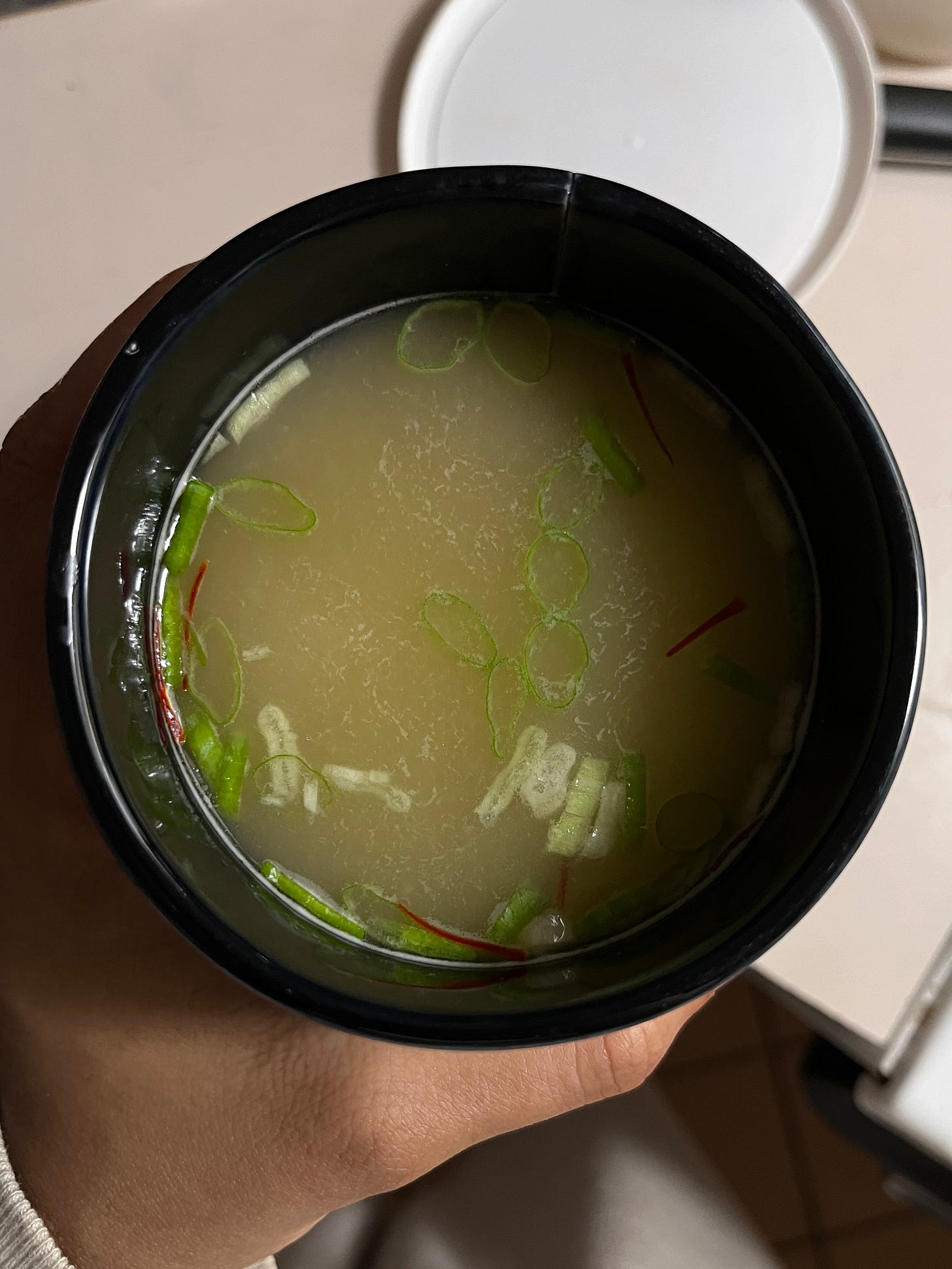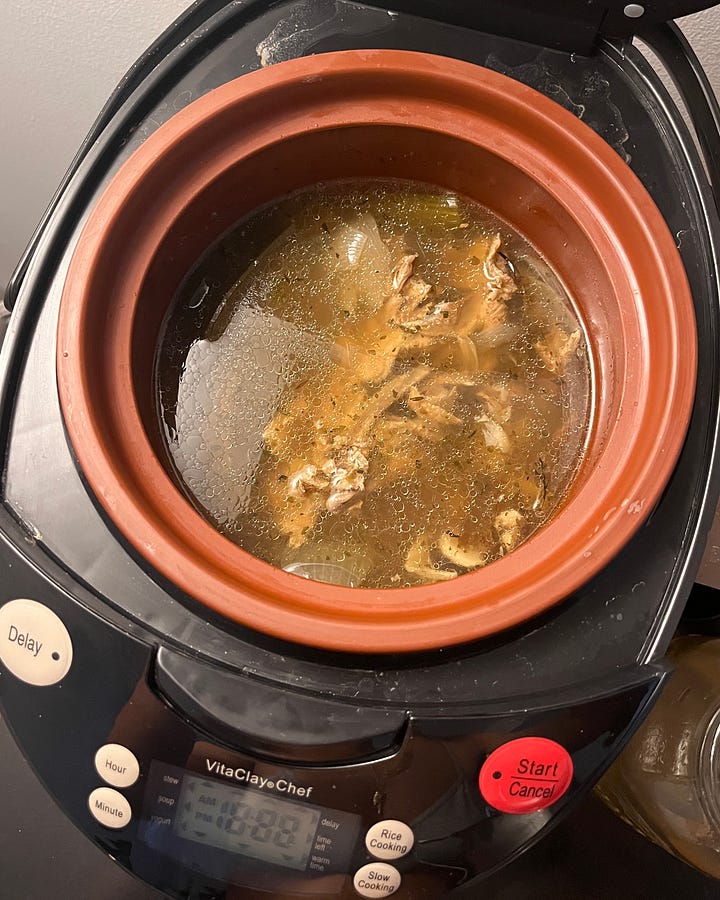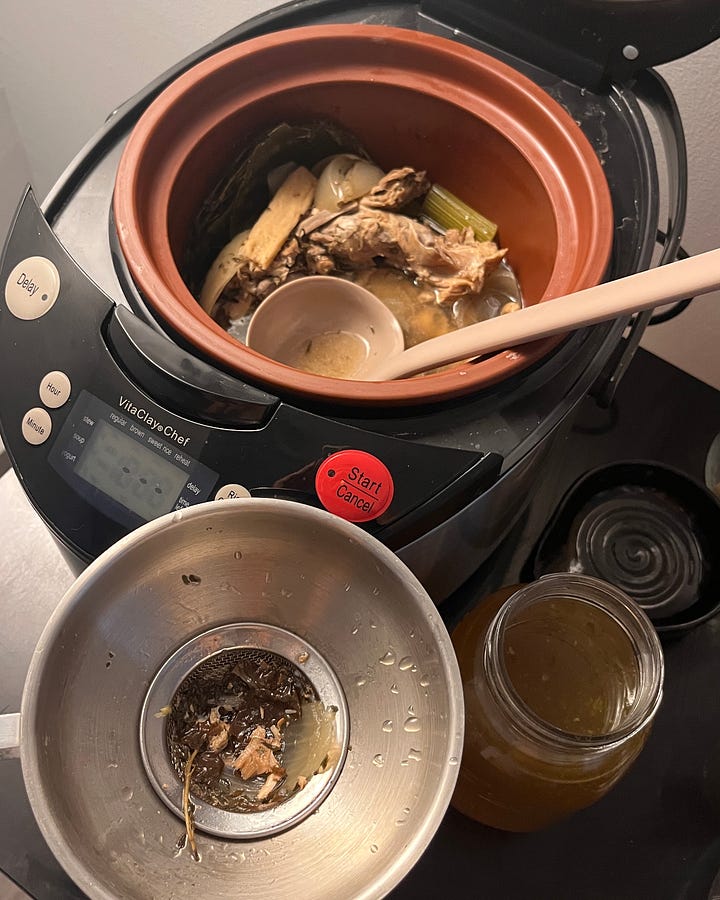Kendyl’s Chicken Bone Broth Recipe
Easy collagen and glycine-rich liquid gold made from using leftover rotisserie chicken
I’m going to do the recipe writer thing here and blab a bit so if you just want my chicken bone broth recipe, you can jump to it here.
If you know me or have followed me for a while, you know that I am always raving about collagen. Collagen has many benefits for helping us to both feel and look good. One major health component of collagen is glycine.
Glycine is an amino acid, and while it is the simplest of these protein building-blocks in terms of its structure, it is the most abundant, and certainly one of the most beneficial. The amino acid has been associated with healthy aging and is found in the body’s connective tissues, joints, tendons, bones, ligaments, and yes—skin. It is deeply reparative and healing for the body, making it great for inside-out recovery and well-being.
Glycine is essential for the body’s production of glutathione, an antioxidant that is deeply important in the process of detoxification and protecting the body against the oxidative damage of free radicals. Glycine has also been found to protect against and reverse liver damage caused by excessive alcohol consumption.
Studies have shown that glycine can improve sleep quality and cuts blood sugar response when consumed along glucose (Dr. Chris Masterjohn has a great piece on glycine), and higher levels of serum glycine in body plasma have also been connected to reduced risk for type 2 diabetes. Those who are type 2 diabetic may therefore benefit from supplementation of or consumption of glycine-rich foods.
As our bodies produce less collagen—and thus, less glycine—as we age, you may want to incorporate glycine into your diet to ensure you continue to reap its benefits. Where supplementing is always an option, one of the best and bioavailable sources of collagen is in meats and cuts that are rich in connective tissue and gelatin, like beef chuck, round, bone-in, skin-on meats, and whole chicken.
Save that carcass!
Cooking a whole chicken in soup is one great way to unleash its collagen into broth. However, using the chicken carcass to make broth after roasting and carving a whole chicken is a sustainable way to get extra nutrients out of it. This is nose-to-tail eating—using every part of the animal for the nutrients it provides. If you want to really up the gelatin content of your broth, I recommend adding chicken feet to the stock.
Today, I’m going to share with you a simple and easy way to make chicken bone broth using bones and scraps you may have leftover from buying or cooking a chicken.
〰
Kendyl’s Chicken Bone Broth Recipe

What you’ll need
1 leftover chicken carcass ― you can roast your own chicken or use a rotisserie, if I do, I get an organic rotisserie from Whole Foods, shredding the meat into a separate container and leaving a little meat still on the bones
1 half large yellow onion, halved
2-4 cloves garlic, crushed
2-inch piece of ginger root, halved or chopped into medallions
1 sheet kombu ― I always add kombu to my stocks for its iodine and mineral content and ability to help digest proteins and detoxify heavy metals and impurities. Kombu is also a rich source of a glutamine, which is restorative of the gut lining.
1 pinch dulse seaweed ― just like kombu, I always add dulse to pots of boiling stock for its rich B vitamin and mineral content and its detoxification properties
1-2 bay leaves
crushed black peppercorns or ground black pepper
salt, to taste
Optional:
the neck of the chicken, if you buy a whole chicken to cook and it is provided along with its giblets ― the neck is rich in connective tissue and collagen
1-2 pounds of chicken paws or feet (claws clipped) — these are rich in connective tissue and will make your broth more gelatinous and jiggly
handful of cilantro ― along with dulse, can support detoxification of heavy metals and other toxins
1-2 tbsps apple cider vinegar — there is some evidence that suggest that adding acid early in the cooking process can help to demineralize the bones and aid in hydrolysis of collagen, helping it to release more readily into the broth, though there are mixed results with this
other herbs, like thyme (great for the respiratory system), oregano (a strong natural anti-microbial), rosemary (antioxidant), and/or nettle (deeply nutritive and antihistamine)
typical stock veggies and veggie scraps such as carrots, celery, etc. (I’ve historically frozen veggie scraps from cooking to make stocks with―onion skins are a great add for their antihistamine quercetin content)
Making it
Add all ingredients to a large stock pot and fill with filtered water just until the bones are covered. Allow to come to a boil on high heat, then reduce to a simmer for 3-6 hours, checking often for water levels. If you are using gelatinous cuts, such as chicken feet or paws, you don’t need to simmer long for the gelatin to be extracted.
You may also make this in a VitaClay Organic Multicooker. You’ll add all ingredients and water to the clay pot, fill it with enough filtered water to cover the bones, and then set the cooker to the Soup setting for 2-3 hours―the clay vessel locks in moisture and takes less time to cook.


After cooking, let the broth cool for 15 minutes and then strain into clean mason jars. I often wait to salt my broth until I use it in soups or to drink on its own. Let broth continue to cool in jars before refrigerating or freezing.
After at least a few hours of chilling in the fridge, you will see if your broth is jiggly or not. I don’t always end up with a jiggly broth, for example, if I use just a carcass or if I add too much water. However, don’t fret—the nutrients and collagen are still there.
Using it
This broth can be used to cook with, such as in soups or to cook rice or pasta with to add protein and make them more nutrient-dense. One of my favorite ways to use bone broth is to sip on with miso paste for a warm, savory, and gut-healing tonic. You can get my easy miso soup recipe here:
Drink up and savor it!
I’d love to hear if you try this recipe and how it goes.
I have other recipes and ways that I like to consume collagen and glycine in my diet, including slow cooked chuck roast and oxtails. Let me know if you want me to share any of these other recipes with you all!
〰
Yours in nourishment,
Liked what you saw here? Follow garlic and dyl on Instagram for more holistic wellness.













This looks so nourishing, Kendyl. I love that you add seaweed!
This is such a great recipe. I’m saving it. I used to drink bone broth every morning, but inflation has the prices up from $6 to $9 for 2 servings!! I’ve been thinking I need to just make my own. I am excited to try this with our next chicken carcass.